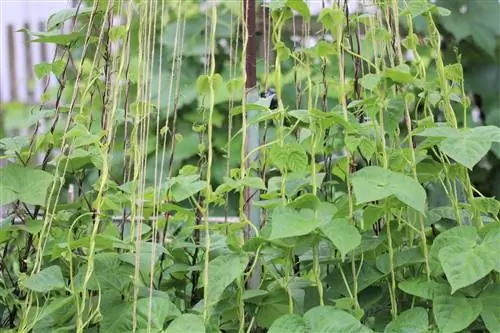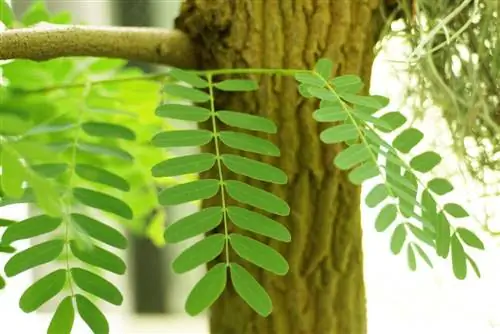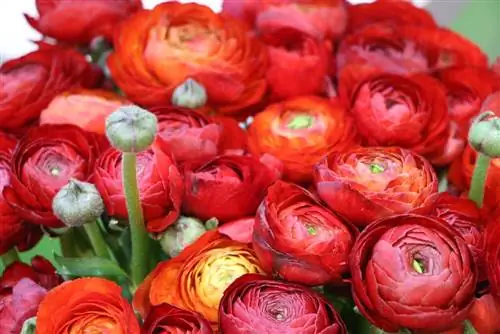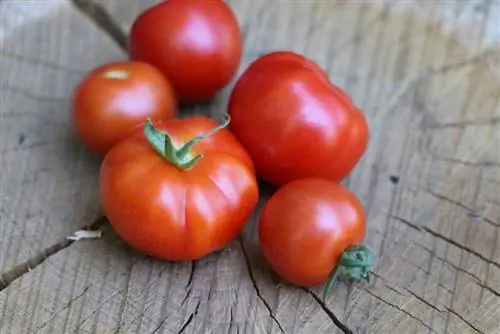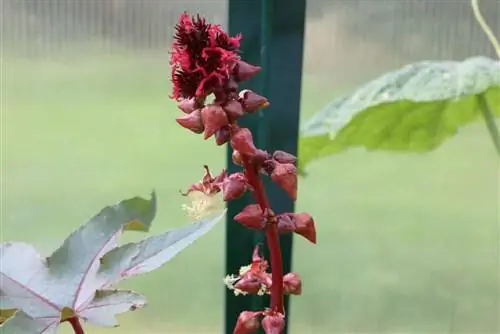- Author admin [email protected].
- Public 2023-12-17 03:39.
- Last modified 2025-01-24 12:45.
Pole beans are climbing plants and therefore require a pole that they can grow along. Since they are not so demanding, the tendrils can even grow up a garden shed or simply on a stick. The soil should be rich in humus and loose, just like the runner beans like to be warm. Therefore, it should be a sunny and wind-protected place, but watering must be carried out regularly when it is dry.
Only sow after the Ice Saints
It should be noted that sowing only takes place after the Ice Saints. Since this is a fast-growing plant, it can still grow up to approx. Sowing takes place at the end of June. It shouldn't be colder than 10 degrees, otherwise the beans won't grow. The warmer the soil, the more resistant the runner beans are to diseases and pests. A distance of 40 centimeters should be maintained for plants. The rows must not be less than 60 centimeters apart, otherwise the plants cannot develop. Once the plants have reached a height of approximately 15 cm, soil should be piled up around the plants. This means they automatically grow along the planting aid.
Growing in a greenhouse is also possible
As a rule, the seeds can be planted straight away. However, this can also be done in a greenhouse and then transferred to the trellises. When sowing directly, 5 to 6 seeds should be placed per climbing aid. You should also fertilize regularly. This can be an organic fertilizer or compost. But bone meal or wood ash also work just as well, because it is important that the fertilizer contains only a little nitrogen.
Regular watering is a must
Since pole beans don't like it dry or too wet, you should always make sure that no water can accumulate when watering. Individual shoots that do not grow along the trellis should be tied counterclockwise. Runner beans need to be watered regularly, especially during the flowering period, because the first beans can be harvested around 10 weeks after sowing. Therefore, always check at regular intervals whether the soil is still moist enough.
Susceptible to diseases
Especially if the beans were planted too early, they are susceptible to a number of diseases. These include spider mites, focal spots and leaf spot diseases. But snails also like runner beans. You don't have to use a chemical bludgeon when it comes to snails; they can be collected by hand. As a preventive measure, a snail fence can be installed or simply fertilized with coffee grounds. Slugs don't really like coffee. If the garden is more natural, it may be possible that these pests do not appear more often, because the hedgehog, for example, takes care of the collection. A garlic decoction or strong basil tea can quickly provide relief against spider mites in the early stages of the infestation. But here too there are useful animals such as predatory mites that like to attack the pests.
Prepare the garden before planting
Before pole beans can be planted, the first important work should be carried out:
- Choose the right location
- Soil, if necessary fertilizer
- Set up planting aids
- Afterwards you can sow and then water
- From a height of 15 cm, place small piles of earth around the plants
- Constantly check whether the beans need water
- Attach loose tendrils to the planting aid counterclockwise
- You may need to fertilize again, depends on the growth
- Continually check for pests or diseases
So that your own runner beans can be harvested
This may sound like a lot of work, but it's a great way to harvest delicious beans. Especially since these plants place a certain amount of demands on the soil, but are therefore very productive. The rapid growth of just 10 weeks also compensates for regular watering and any additional fertilization. If the soil is a little too firm, it needs to be loosened again and again. Just as of course the weeds between the plants must be removed, otherwise they will influence or even prevent growth.
Easy to recognize ripe beans
After the first beans are ripe about 10 weeks, they must also be recognized. This is easy because they can be broken easily and, above all, smoothly when bent. Unripe runner beans either cannot be broken or are very difficult to break and then there is no smooth break. It is also important that the crops are not harvested on a regular basis, otherwise the plant may become ill. Beans should also never be eaten raw as they contain a toxic protein and phasin. This can lead to stomach and intestinal problems and even vomiting. Therefore, cook the beans first, no matter how delicious they look.
Pole beans must be planted every year
With this type of bean it is not possible to overwinter the plants. This means they have to be replanted every year, always with the same effort. However, this work is worth it because these beans can fit even in the smallest garden. This is because they grow upwards and not in width. This means pole soil can be planted in any garden as long as it is suitable soil. As long as there is enough sun and water, not much can go wrong with runner beans. However, you should always check that the soil is loose. Otherwise, water can build up in hard soil and beans don't like that. Anyone who follows these tips will have a rich harvest. Above all, runner beans can be boiled or simply frozen. This can be done raw, but they must be properly cut beforehand. Always fresh and delicious beans all year round.
What you need to know and care tips
Runner beans are climbing plants up to three meters high and prefer a sunny, warm but sheltered place. These plants are demanding and tolerate neither prolonged dryness nor permanent wetness. In addition, the soil in which they are to grow should be deep and rich in humus. The work was put in place before sowing the runner beans. Here the craftsman can live to his full potential and make a pole frame made of wood or metal as a climbing aid. Which material you choose is up to the hobby gardener. If you don't want to make this climbing aid yourself, you can of course also buy it at a hardware store.
This climbing aid can take different forms. You could simply stick a stick into the ground so that the plants can climb up it, or attach several poles in the shape of a wigwam. As a rule, five to six rods are used, which are connected together at the top. Of course, the climbing aid can also be built in such a way that two poles are always connected to each other. Stability is achieved by placing another pole on top of the poles.
The time for sowing depends on the location of the garden and the weather. It is ideal if the soil temperature is at least 10 degrees Celsius. When sowing pole beans, around six to eight seeds are sown around the poles. There should be a distance of around forty centimeters between the poles and around 60 between the rows. When the plants have reached a height of around 15 centimeters, the earth is piled up all around and the shoots are guided to the climbing aid.
When caring for runner beans, make sure that the soil around the plants never dries out. Runner beans need to be watered regularly, especially when they are in bloom. When watering, care must also be taken to ensure that waterlogging does not occur. In order for the runner beans to thrive, it is important to tie up the hanging shoots in a counterclockwise direction. Runner beans are quite susceptible to snails, spider mites, leaf spot and common blotch.
Runner beans are very productive. They can therefore be harvested for the first time just 10 weeks after sowing. From this moment on you can pick continuously until autumn. However, you should make sure that the tendrils are not damaged or torn off. When consuming runner beans, it is important to ensure that these legumes are not eaten raw because they contain toxins. However, heating the beans renders this poison ineffective. Cooked runner beans are served as a salad or as a vegetable. They can be preserved in many ways. They can be frozen, boiled or pickled. There are green-podded and blue-podded pole beans or yellow-podded wax beans.

